Related Research Articles

Anaximenes of Miletus was an Ancient Greek, Pre-Socratic philosopher from Miletus in Anatolia. He was the last of the three philosophers of the Milesian School, after Thales and Anaximander. These three are regarded by historians as the first philosophers of the Western world. Anaximenes is known for his belief that air is the arche, or the basic element of the universe from which all things are created. Little is known of Anaximenes' life and work, as all of his original texts are lost. Historians and philosophers have reconstructed information about Anaximenes by interpreting texts about him by later writers. All three Milesian philosophers were monists who believed in a single foundational source of everything: Anaximenes believed it to be air, while Thales and Anaximander believed it to be water and an undefined infinity, respectively. It is generally accepted that Anaximenes was instructed by Anaximander, and many of their philosophical ideas are similar. While Anaximenes was the preeminent Milesian philosopher in Ancient Greece, he is often given lower importance than the others in the modern day.
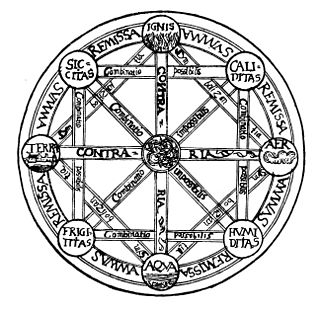
The classical elements typically refer to earth, water, air, fire, and (later) aether which were proposed to explain the nature and complexity of all matter in terms of simpler substances. Ancient cultures in Greece, Tibet, and India had similar lists which sometimes referred, in local languages, to "air" as "wind" and the fifth element as "void".

New Age is a range of spiritual or religious practices and beliefs which rapidly grew in Western society during the early 1970s. Its highly eclectic and unsystematic structure makes a precise definition difficult. Although many scholars consider it a religious movement, its adherents typically see it as spiritual or as unifying Mind-Body-Spirit, and rarely use the term New Age themselves. Scholars often call it the New Age movement, although others contest this term and suggest it is better seen as a milieu or zeitgeist.
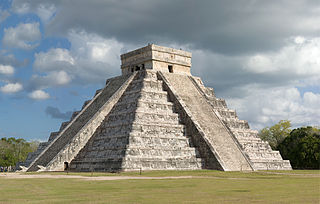
In the history of the Americas, the pre-Columbian era spans from the original peopling of the Americas in the Upper Paleolithic to European colonization, which began with Christopher Columbus's voyage of 1492. Usually, the era covers the history of Indigenous cultures until significant influence by Europeans. This may have occurred decades or even centuries after Columbus for certain cultures.
Transculturation is a term coined by Cuban anthropologist Fernando Ortiz in 1940 to describe the phenomenon of merging and converging cultures. Transculturation encompasses more than transition from one culture to another; it does not consist merely of acquiring another culture (acculturation) or of losing or uprooting a previous culture (deculturation). Rather, it merges these concepts and instead carries the idea of the consequent creation of new cultural phenomena (neoculturation) in which the blending of cultures is understood as producing something entirely new.
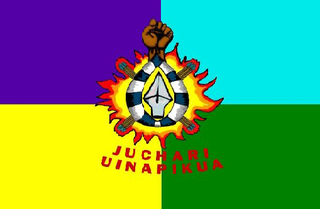
The Purépecha are a group of Indigenous people centered in the northwestern region of Michoacán, Mexico, mainly in the area of the cities of Cherán and Pátzcuaro.
Cultural ecology is the study of human adaptations to social and physical environments. Human adaptation refers to both biological and cultural processes that enable a population to survive and reproduce within a given or changing environment. This may be carried out diachronically, or synchronically. The central argument is that the natural environment, in small scale or subsistence societies dependent in part upon it, is a major contributor to social organization and other human institutions. In the academic realm, when combined with study of political economy, the study of economies as polities, it becomes political ecology, another academic subfield. It also helps interrogate historical events like the Easter Island Syndrome.
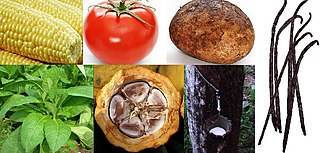
The Columbian exchange, also known as the Columbian interchange, was the widespread transfer of plants, animals, precious metals, commodities, culture, human populations, technology, diseases, and ideas between the New World in the Western Hemisphere, and the Old World (Afro-Eurasia) in the Eastern Hemisphere, in the late 15th and following centuries. It is named after the Italian explorer Christopher Columbus and is related to the European colonization and global trade following his 1492 voyage. Some of the exchanges were purposeful; some were accidental or unintended. Communicable diseases of Old World origin resulted in an 80 to 95 percent reduction in the number of Indigenous peoples of the Americas from the 15th century onwards, most severely in the Caribbean. The cultures of both hemispheres were significantly impacted by the migration of people from the Old World to the New. European colonists and African slaves replaced Indigenous populations across the Americas, to varying degrees. The number of Africans taken to the New World was far greater than the number of Europeans moving to the New World in the first three centuries after Columbus.
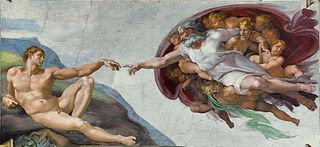
Progressive creationism is the religious belief that God created new forms of life gradually over a period of hundreds of millions of years. As a form of old Earth creationism, it accepts mainstream geological and cosmological estimates for the age of the Earth, some tenets of biology such as microevolution as well as archaeology to make its case. In this view creation occurred in rapid bursts in which all "kinds" of plants and animals appear in stages lasting millions of years. The bursts are followed by periods of stasis or equilibrium to accommodate new arrivals. These bursts represent instances of God creating new types of organisms by divine intervention. As viewed from the archaeological record, progressive creationism holds that "species do not gradually appear by the steady transformation of its ancestors; [but] appear all at once and "fully formed."
In cultural anthropology and cultural geography, cultural diffusion, as conceptualized by Leo Frobenius in his 1897/98 publication Der westafrikanische Kulturkreis, is the spread of cultural items—such as ideas, styles, religions, technologies, languages—between individuals, whether within a single culture or from one culture to another. It is distinct from the diffusion of innovations within a specific culture. Examples of diffusion include the spread of the war chariot and iron smelting in ancient times, and the use of automobiles and Western business suits in the 20th century.
Spiritual ecology is an emerging field in religion, conservation, and academia that proposes that there is a spiritual facet to all issues related to conservation, environmentalism, and earth stewardship. Proponents of spiritual ecology assert a need for contemporary nature conservation work to include spiritual elements and for contemporary religion and spirituality to include awareness of and engagement in ecological issues.

A tribal chief, chieftain, or headman is the leader of a tribal society or chiefdom.

'Asabiyyah is a concept of social solidarity with an emphasis on unity, group consciousness, and a sense of shared purpose and social cohesion, originally used in the context of tribalism and clanism.

Mesoamerica is a historical region and cultural area that begins in the southern part of North America and extends to the Pacific coast of Central America, thus comprising the lands of central and southern Mexico, all of Belize, Guatemala, El Salvador, and small parts of Honduras, Nicaragua and Costa Rica. As a cultural area, Mesoamerica is defined by a mosaic of cultural traits developed and shared by its indigenous cultures.
Latin American culture is the formal or informal expression of the people of Latin America and includes both high culture and popular culture, as well as religion and other customary practices. These are generally of Western origin, but have various degrees of Native American, African and Asian influence.

Mexican muralism refers to the art project initially funded by the Mexican government in the immediate wake of the Mexican Revolution (1910-1920) to depict visions of Mexico's past, present, and future, transforming the walls of many public buildings into didactic scenes designed to reshape Mexicans' understanding of the nation's history. The murals, large artworks painted onto the walls themselves had social, political, and historical messages. Beginning in the 1920s, the muralist project was headed by a group of artists known as "The Big Three" or "The Three Greats". This group was composed of Diego Rivera, José Clemente Orozco and David Alfaro Siqueiros. Although not as prominent as the Big Three, women also created murals in Mexico. From the 1920s to the 1970s, murals with nationalistic, social and political messages were created in many public settings such as chapels, schools, government buildings, and much more. The popularity of the Mexican muralist project started a tradition which continues to this day in Mexico; a tradition that has had a significant impact in other parts of the Americas, including the United States, where it served as inspiration for the Chicano art movement.

Political globalization is the growth of the worldwide political system, both in size and complexity. That system includes national governments, their governmental and intergovernmental organizations as well as government-independent elements of global civil society such as international non-governmental organizations and social movement organizations. One of the key aspects of the political globalization is the declining importance of the nation-state and the rise of other actors on the political scene. The creation and existence of the United Nations is called one of the classic examples of political globalization.
Mesoamerican cosmovision or cosmology is the collection of worldviews shared by the Indigenous pre-Columbian societies of Mesoamerica. The cosmovision of these societies was reflected in the ways in which they were organized, such as in their built environment and social hierarchies, as well as in their epistemologies and ontologies, including an understanding of their place within the cosmos or universe. Elements of Mesoamerican cosmovision are reflected in pre-Columbian textual sources, such as the Popol Vuh and the Cuauhtinchan maps, the archeological record, as well as in the contemporary beliefs, values, and practices of Indigenous people, such as the Maya, Nahua, and Purépecha, as well as their descendants. It has been argued that the Day of the Dead ceremony exists as a legacy of Mesoamerican cosmovision.

Rights of nature or Earth rights is a legal and jurisprudential theory that describes inherent rights as associated with ecosystems and species, similar to the concept of fundamental human rights. The rights of nature concept challenges twentieth-century laws as generally grounded in a flawed frame of nature as "resource" to be owned, used, and degraded. Proponents argue that laws grounded in rights of nature direct humanity to act appropriately and in a way consistent with modern, system-based science, which demonstrates that humans and the natural world are fundamentally interconnected.
Te Ao Mārama is a concept of the world in Māori culture. Te Ao Mārama, also known as Te Ao Tūroa, refers to the physical plane of existence that is inhabited by people, and is associated with knowledge and understanding. The phrase is variously translated as "The World of Light", "the World of Understanding" and "the Natural World".
References
- ↑ Schweimler, Daniel (2006-01-21). "Latin America's winds of change". From Our Own Correspondent. BBC News. Retrieved 2006-06-09.